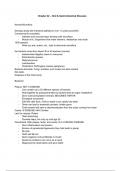Class notes
Oral and Gastrointestinal Microbiology
- Course
- Bio 250 (BIO250)
- Institution
- University Of South Carolina
Description of normal microflora and lifespan. Explanations of oral bacteria and side effects of left untreated. Viral versus Fungal Types of bacteria involved in gastrointestinal diseases with onset time and side effects
[Show more]



